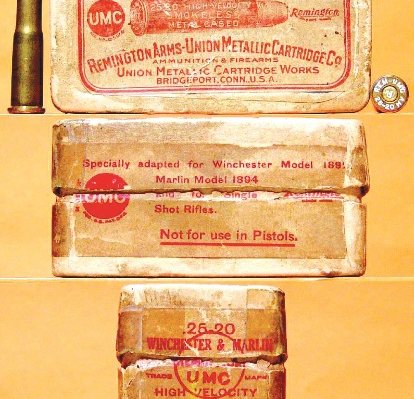Removing A Stuck Case From Your Die
- By Wheelwrite
-
1
 Comments
Comments
- Last updated: 01/12/2016

During the late 19th and early 20th Centuries, one arms company above all others was responsible for the introduction of a bewildering range of metallic centrefire cartridges. Even more confusing was the seemingly duplicated performance produced by many sub-groups within these designs. Almost all were intended for use in their burgeoning range of repeating rifles and most had their roots in the use of black powder. Hence the mind numbing nomenclatures. In no particular order, .32-20, .44-40, .45-60, .45-70, .32-40, .38-40, .38-55, .38-56, .38-70, .38-72, .40-65, .40-72 and on and on. Yup, you’ve worked it out, Winchester. The headstamps often reading WCF, (Winchester Center Fire).
Our chosen child from this era is the .25-20 Winchester (aka 25-20 WCF). It’s parent was the 1882 .32-20 Winchester, aka .32 WCF, not that this was the first to wear the .25-20 badge, as a single shot wildcat pre-dated it by almost a decade and was probably the inspiration for the Winchester design). Introduced somewhere between 1892 and 1895, the paper thin rimmed .32-20 case was necked down to accommodate an 86-grain, .258” flat-nosed lead pill. The 20-grain black powder charge generating 1460 fps.
A slightly later ‘high velocity’ variant using a 60-grain SP was also listed, quoting 2250 fps but with no confirmation of the charge weight (probably early nitro). Bullet design reflected Winchesters intended use in a new chambering in their Model 1892 Lever Action. Aimed at the small/ medium game and varmint market it soon became a popular backwoods rifle and cartridge combo. Whilst modest exterior ballistics limited the practical working range to between 75 and 100 yards the scale of the market encouraged other rifle builders to chamber it.
However, whilst Marlin offered their Models 1889 and 1894 in .25-20 WCF they later introduced a rifle chambering and matching cartridge in .25-20 MARLIN. On the face of it they have the same design and ballistics. In addition to Winchester, other ammo makers have made it, but over time the bullet diameter has become .257” and the range of weights and loadings extended to span 50 to 100-grains.
There has always been a buoyant collector market for arms chambered for the old WCF cartridges, especially lever actions, ensuring that both tools and materials will continue to be available. The .25-20 WCF certainly qualifies as one of these stars, especially since there were chamberings in not only a diverse range of rifles but several models of revolver. So a great candidate for S7 collector/shooters handguns. Furthermore, there are suitable comps for classic long guns too.
On the loading bench the usual warnings apply. Only use truncated bullet designs in any tube mag guns, be wary of modern nitro loads in early rifles and take account of the .001” change in bullet diameter from the original WCF design. If you’re going to revive one of the old revolvers as a shooter, take heed of all the pressure warnings.
You’ll find limited load data in a number of the manuals. Bullets in .257” are listed by several makers. Whilst I could find un-primed brass from Remington I could not find any new Winchester cases. Although modern brass is slightly more robust than the early examples, it is still quite flimsy, making light loading a sensible choice. Propellants are in the slow pistol/fast rifle region, including H4198, H110, 2400 and my favourite, IMR 4227. Tools are catalogued by Lee, Lyman, RCBS, Redding and Hornady. What are you waiting for? A true classic at a sensible price.
